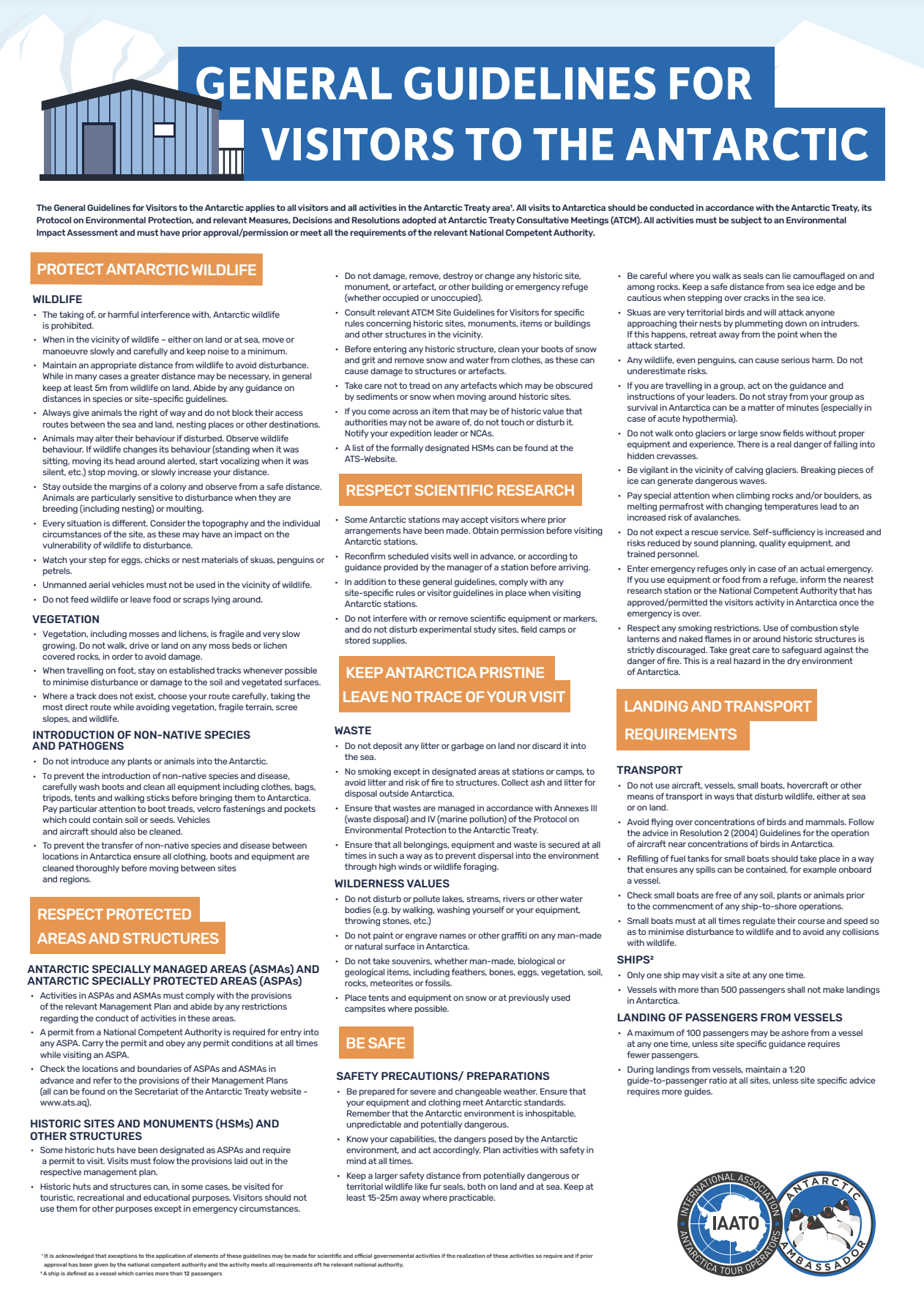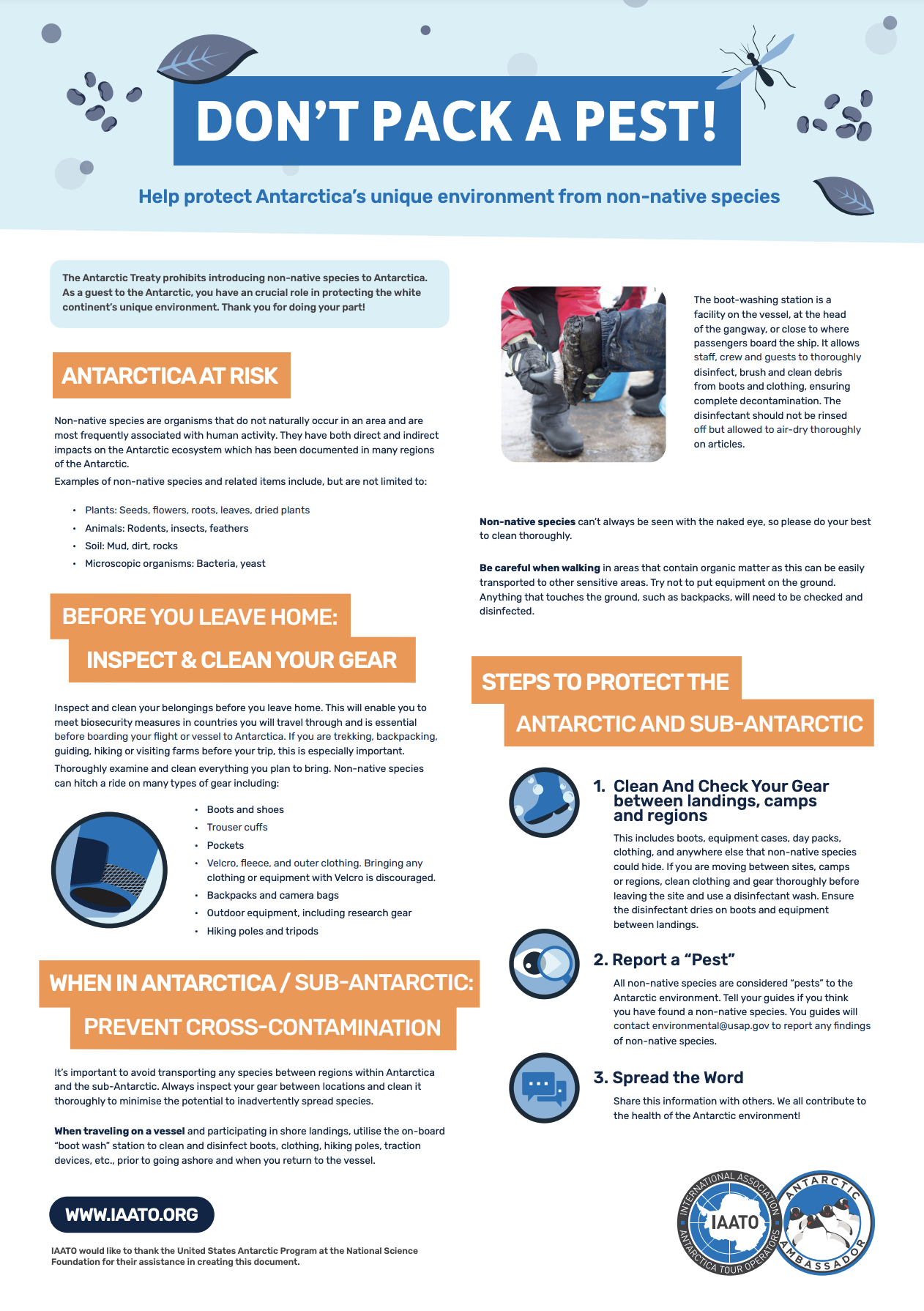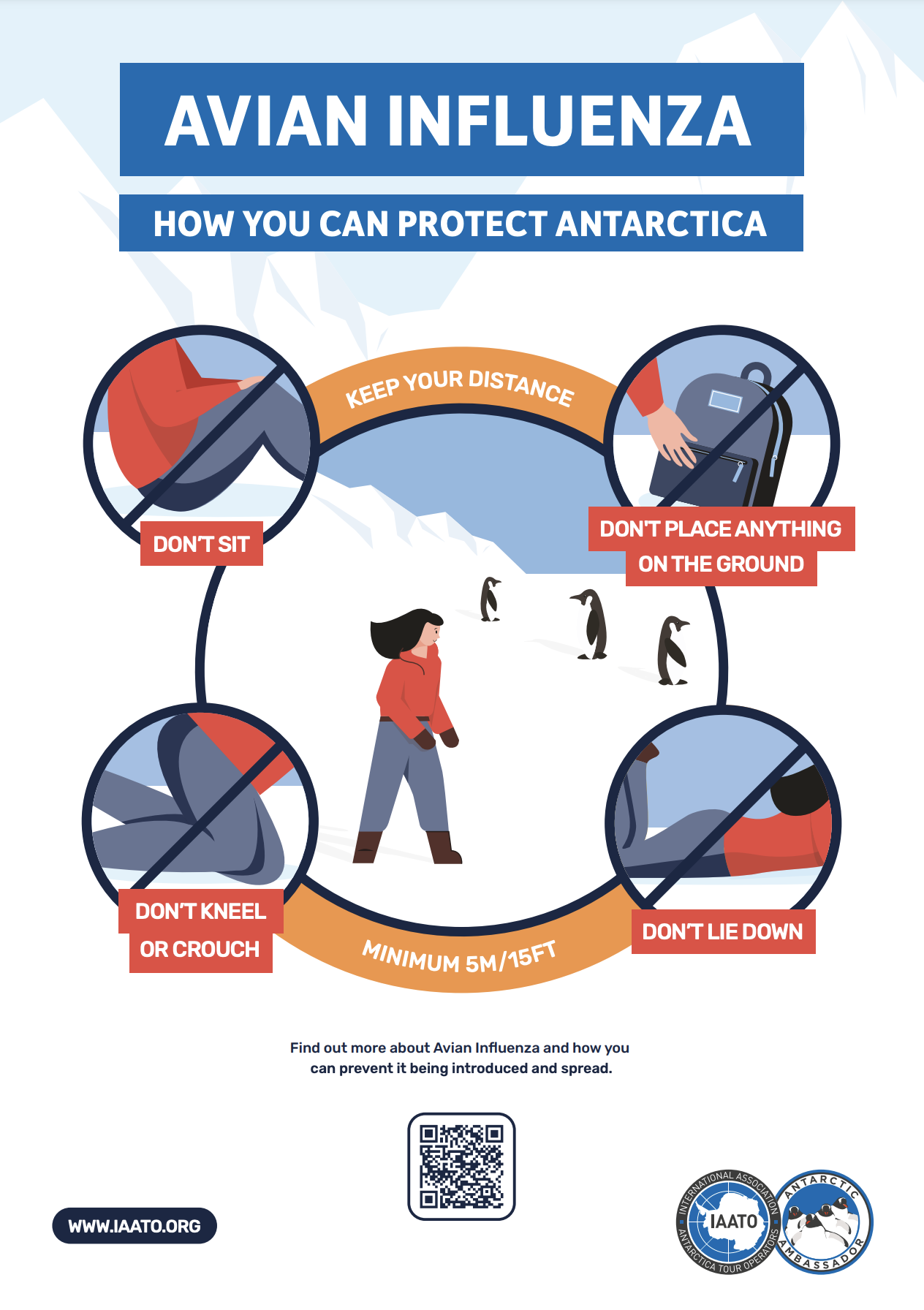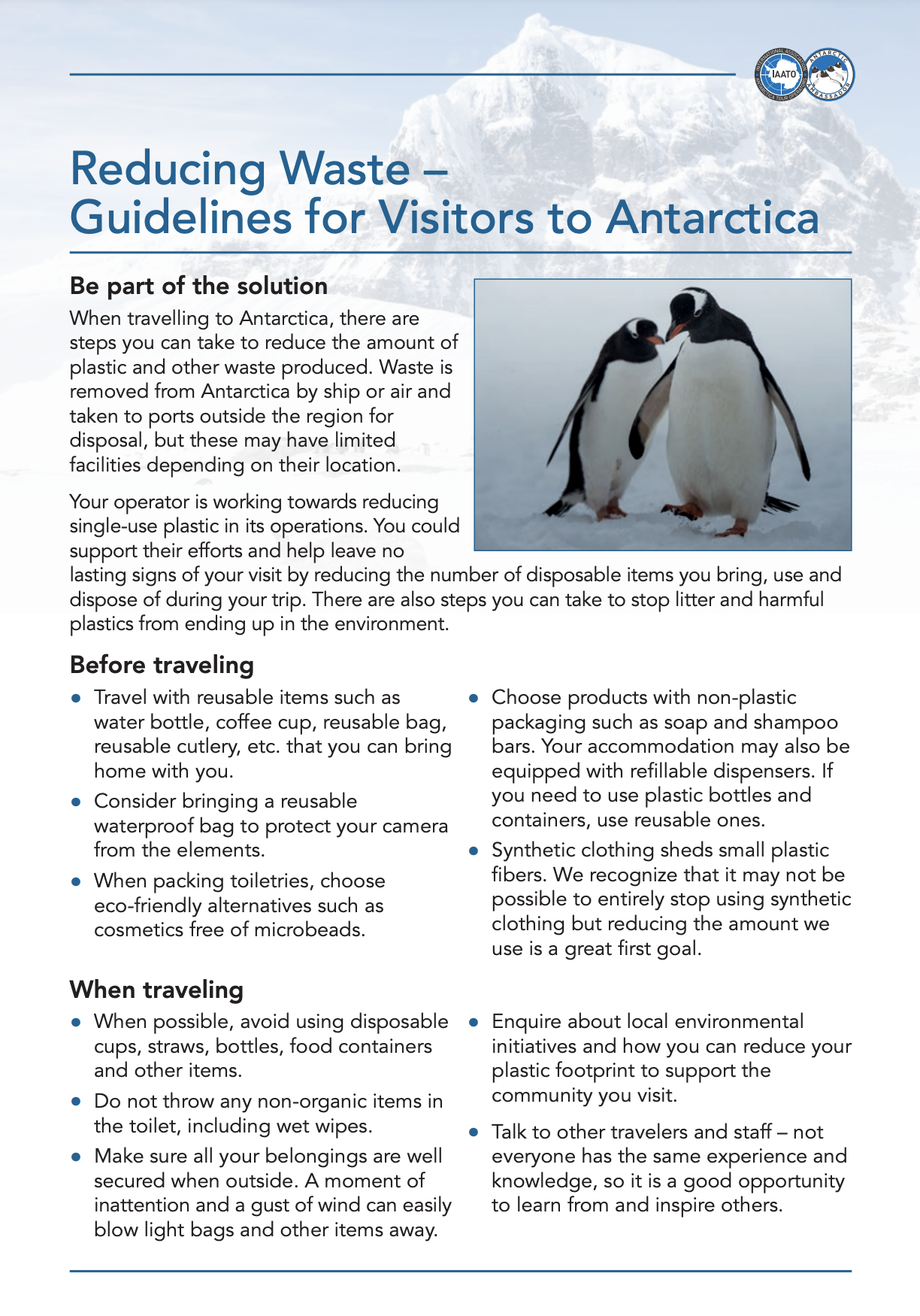IAATO Guidelines for Responsible Tourism in Antarctica
Understanding IAATO and the Importance of IAATO Guidelines
On an Antarctic cruise, you’ll frequently hear about IAATO and the importance of following IAATO guidelines. IAATO, short for the International Association of Antarctica Tour Operators, is a global organisation established in 1991. With more than 100 member organisations and companies, IAATO’s mission is to promote safe, environmentally responsible tourism in Antarctica. This collective aims to ensure that private sector tourism to Antarctica preserves the continent’s unique ecosystems and prioritises visitor education.
IAATO collaborates closely with Antarctic tour operators to minimise tourism’s impact on the environment while creating a meaningful and sustainable experience for visitors. By setting and enforcing IAATO guidelines, the organisation protects Antarctica’s fragile ecosystem and ensures that future generations can continue to experience its pristine beauty.
Expectations for Passengers Following IAATO Guidelines
All operators running Antarctic cruises adhere strictly to IAATO guidelines, and as a passenger, you’ll be expected to follow them as well. IAATO guidelines aren’t just recommendations—they are essential for maintaining access to the continent’s sensitive areas.
If passengers ignore or disregard these rules, they risk losing privileges such as land excursions and zodiac cruises for the remainder of their trip, with no exceptions. However, there’s no need for concern; expedition guides provide a thorough introduction to IAATO guidelines at the start of the journey and offer support throughout your cruise to ensure compliance.
Takea look at the IAATO posters below. Click on the images to go to the documents.
Key IAATO Guidelines for Landing on the Antarctic Peninsula
One of the most critical IAATO guidelines involves managing visitor numbers at landing sites. To protect wildlife habitats and prevent overcrowding, IAATO restricts the number of passengers ashore to no more than 100 at any given time.
Qualified guides accompany all visitors to ensure that each person adheres to IAATO guidelines, safeguarding both the environment and visitor experience. This controlled approach maintains the integrity of landing sites, enhances safety, and allows for a more enjoyable experience for everyone on the expedition.
Wildlife distance and interactions
When you land on the Antarctic Peninsula, you’ll encounter a variety of unique wildlife. IAATO guidelines stress the importance of maintaining a safe distance from animals to avoid disturbing them.
The IAATO guidelines provide specific rules regarding wildlife distances to ensure minimal disturbance to the animals and the environment. However, it is important to note that IAATO rules are overruled by government regulations where applicable.
Here are the key points related to maintaining appropriate distances from wildlife:
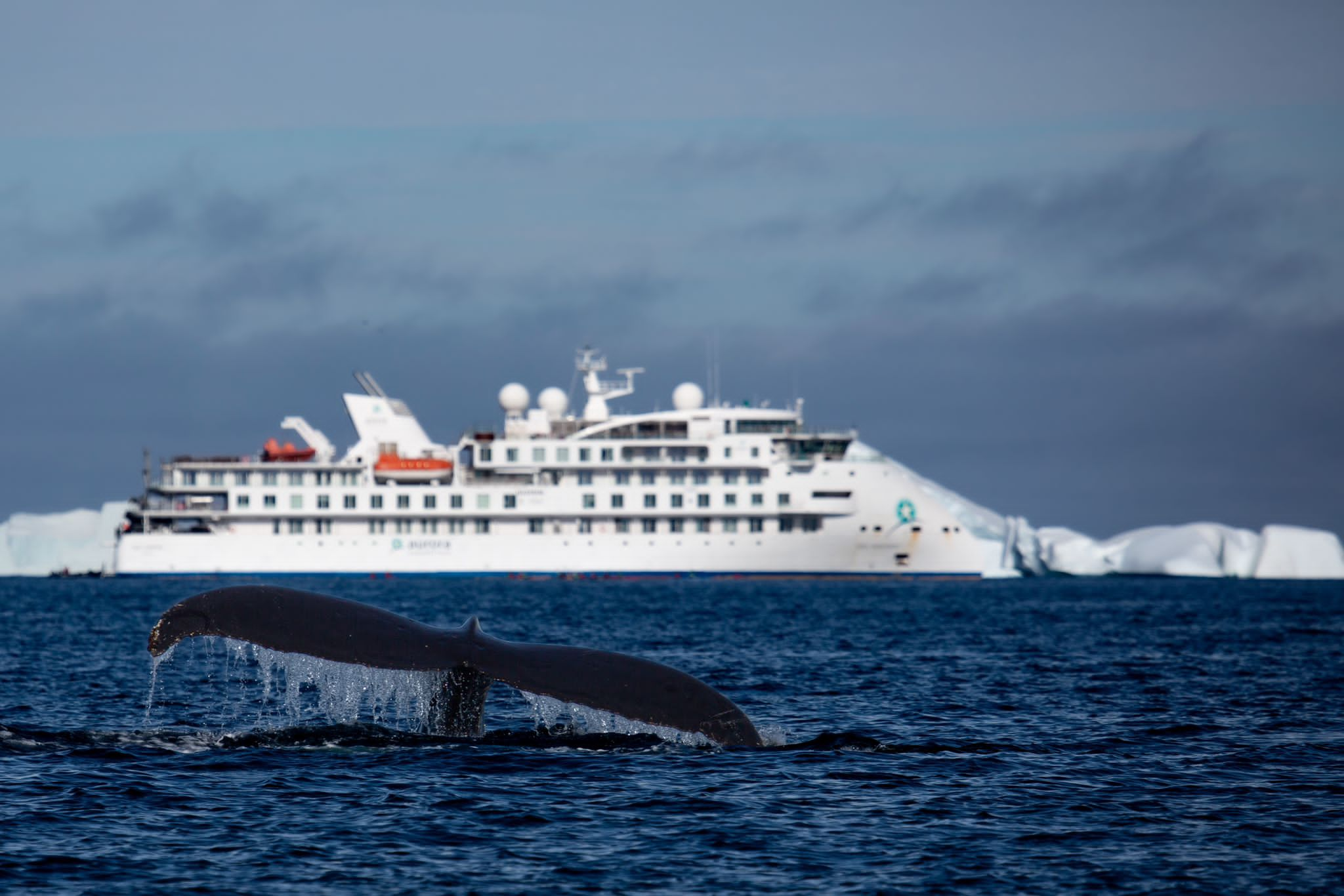
- Visitors must maintain a minimum distance of at least 5 metres (16 feet) from all wildlife, including seals, birds, and other animals. This helps prevent stress and disturbances to the animals.
- Some species or situations may require greater distances. For example, during the breeding season or when animals exhibit signs of stress, it is advisable to increase the distance to avoid any negative impact. Your antarctic cruise operator will inform you of the rules you must follow before you embark onto the zodiac.
- Always follow the instructions of your expedition guide, who is trained to understand and mitigate the impacts on wildlife. They will provide specific advice based on the current situation and the behaviour of the animals.
- When observing penguin colonies, visitors should not approach closer than 5 metres. If the penguins move towards you, remain still and allow them to pass. Never block penguin highways.
- Do not position yourself in a way that blocks the path of animals, particularly those that are heading to or from the sea.
Maintain a distance of at least 15 metres (50 feet) from seals that are hauled out on land or ice. Seals can be unpredictable and potentially dangerous if approached too closely.
Visitors must stay at least 5 metres away from bird nests to avoid causing distress or abandonment by the parent birds.
When visiting wildlife areas, groups should be kept small to minimise impact. IAATO guidelines recommend that no more than 20 people should be within a viewing distance of wildlife at any one time, and always under the supervision of a guide.
- If an animal changes its behaviour because of your presence, you are too close and should slowly back away. Signs of disturbance can include altered body posture, increased vocalisation, or movement away from you.
- Do not crouch down or make sudden movements that could startle wildlife. Stay upright and move slowly and calmly.
IAATO Guidelines: Ensuring Responsible and Sustainable Antarctic Tourism
Adhering to IAATO guidelines is essential for preserving Antarctica’s wildlife and maintaining the region’s natural behaviours undisturbed by human presence. These rules are crucial for protecting the fragile Antarctic ecosystem and ensuring that tourism does not harm its unique biodiversity. However, visitors should also be aware that IAATO guidelines must be followed alongside any applicable government regulations in the region.
Safety Protocols for Antarctic Expeditions
Safety is paramount in IAATO’s guidelines. Before each landing, operators provide comprehensive briefings covering potential hazards and emergency procedures. These guidelines require that all tour operators have the necessary equipment and trained staff to address medical issues, accidents, or other risks in Antarctica’s harsh environment. By following these safety measures, travellers contribute to a secure experience for themselves and their companions.
Take a look at the IAATO Guidance for reducing waste and minimising the spread of avian influenza. Click on the images to go to the documents.
Waste Management
Effective waste management is a key priority in IAATO guidelines. All visitors must carry any waste, including human waste, back to the ship for proper disposal. Strict no-littering policies are enforced by all Antarctic operators, and to prevent introducing non-native species, visitors must clean footwear and equipment before each landing.
This process includes brushing off soil and seeds and disinfecting boots with solutions like Virkon. Such biosecurity measures are especially vital now, with avian flu detected in Antarctica, underscoring the need to protect the ecosystem from invasive species.
IAATO Guidelines on Avian Influenza
To mitigate the spread of avian influenza, IAATO has implemented additional protective measures. Visitors are required to disinfect clothing and equipment before and after visiting bird colonies. Additionally, avoiding contact with sick or dead birds and immediately reporting any sightings to guides helps protect Antarctica’s bird populations. These actions are crucial for maintaining the ecosystem’s health and safeguarding its wildlife.
Supporting Scientific Research and Education
IAATO encourages the integration of scientific research and educational opportunities into Antarctic tourism. Visitors often have chances to support research projects and learn about the importance of conserving Antarctica’s unique ecosystems. Operators frequently share information about the region’s wildlife, climate, and human impact. This educational approach fosters a deeper understanding of the continent and promotes a sense of responsibility among visitors.
Commitment to Sustainable Tourism
The IAATO guidelines underscore a strong commitment to sustainable tourism in Antarctica. By adhering to these principles, visitors help ensure minimal environmental impact while maximising safety and enjoyment. These guidelines are essential for maintaining one of the world’s last great wildernesses, enabling future generations to experience its pristine landscapes.
IAATO’s comprehensive guidelines, covering visitor management, wildlife protection, environmental safeguards, safety protocols, and support for scientific research, provide a vital framework for responsible tourism in Antarctica. Following these guidelines allows passengers to actively contribute to the conservation of this unique and delicate region.
Further reading
For more information about the IAATO guidelines, or to view the above posters in languages other thn English, go to IAATO’s website here.
Back To Top

